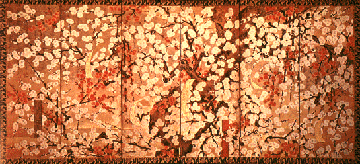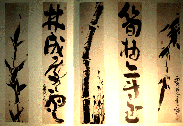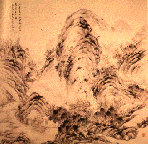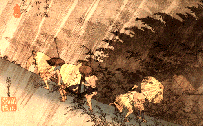


In particular, Japan was closed to contact with Europeans from the 17th to the mid-19th century, when the American Admiral Perry forced the Japanese to open trade with the west. Once contact was made, Japanese arts became the sensation of the later 19th century in Europe and the United States, and were very important in the development of both fine arts and decorative arts in Europe and America throughout the late 19th and early 20th centuries.
 The most distinctly Japanese religious tradition is Shintoism,
based on ancient belief systems. Nature, in the most ancient religions, is filled
with gods, so that the world is animated by the divine. The sun goddess is chief
among these deities, and the emperor is her son. Just as with Confucianism in
China, one's ancestors and one's family are the link with the sacred. Shintoism
continues to be an important feature of Japanese spiritual life.
The most distinctly Japanese religious tradition is Shintoism,
based on ancient belief systems. Nature, in the most ancient religions, is filled
with gods, so that the world is animated by the divine. The sun goddess is chief
among these deities, and the emperor is her son. Just as with Confucianism in
China, one's ancestors and one's family are the link with the sacred. Shintoism
continues to be an important feature of Japanese spiritual life.
 Buddhism reached Japan in the late 6th century AD. Along with the new religion
came a period of strong Chinese influence which can be seen in all of the arts.
This remained a strong factor during the Nara period (through the 8th century),
but after the 9th century, Chinese influence became weaker. A peculiarly Japanese
strain of Buddhism arose in the 14th century, which came to be known as Zen
Buddhism. Zen Buddhists follow the teachings of Amida Buddha, which stress
a life of contemplation and study, and in which contemplation of nature plays
an important part. The purpose of the contemplative withdrawal from the world,
however, is to renew the spirit in order to return to the world and serve.
Buddhism reached Japan in the late 6th century AD. Along with the new religion
came a period of strong Chinese influence which can be seen in all of the arts.
This remained a strong factor during the Nara period (through the 8th century),
but after the 9th century, Chinese influence became weaker. A peculiarly Japanese
strain of Buddhism arose in the 14th century, which came to be known as Zen
Buddhism. Zen Buddhists follow the teachings of Amida Buddha, which stress
a life of contemplation and study, and in which contemplation of nature plays
an important part. The purpose of the contemplative withdrawal from the world,
however, is to renew the spirit in order to return to the world and serve.
 Literacy came to Japan via China, and the Chinese system of writing was adopted.
Although a phonetic alphabet was also developed, the
pictographic
characters remained important, and as in China, the result was that visual
symbolism associated with plants, animals, and other objects strongly affected
the content and meaning of Japanese art and design.
Literacy came to Japan via China, and the Chinese system of writing was adopted.
Although a phonetic alphabet was also developed, the
pictographic
characters remained important, and as in China, the result was that visual
symbolism associated with plants, animals, and other objects strongly affected
the content and meaning of Japanese art and design.
Chinese painting style was influential in the early development of Japanese
painting, but particularly after the 14th century, Japanese painting developed
in different ways. These differences became pronounced during the 17th-19th
centuries when Japan isolated herself from the outside world.
 Japanese painting tended to be both more abstract and more naturalistic than
Chinese painting, depending on the artist and the subject. Japanese style allowed
for greater spontaneity and individuality. Although Japanese landscapes and
panoramic scroll painting featured shifting perspective, like Chinese painting,
many works focussed on more intimate and limited subjects, permitting more explicit
perspective and lighting effects. Individual portraits, scenes of daily life,
studies of plants and animals were done, and these images were handled with
spontaneity and individualism. In contrast to the more decorative Chinese aesthetics,
Japanese style tends toward a paring down to essentials, an attempt to capture
the basic form and characteristics of a specific subject. Also a style of painting
called Ukiyo-e,
which became known to Westerners mainly through woodcut prints in the 19th
century, developed very distinctive, dramatic ways of using line and color in
landscape, portraiture, and other subjects. Ukiyo-e prints had an important
effect on the work of Western artists.
Japanese painting tended to be both more abstract and more naturalistic than
Chinese painting, depending on the artist and the subject. Japanese style allowed
for greater spontaneity and individuality. Although Japanese landscapes and
panoramic scroll painting featured shifting perspective, like Chinese painting,
many works focussed on more intimate and limited subjects, permitting more explicit
perspective and lighting effects. Individual portraits, scenes of daily life,
studies of plants and animals were done, and these images were handled with
spontaneity and individualism. In contrast to the more decorative Chinese aesthetics,
Japanese style tends toward a paring down to essentials, an attempt to capture
the basic form and characteristics of a specific subject. Also a style of painting
called Ukiyo-e,
which became known to Westerners mainly through woodcut prints in the 19th
century, developed very distinctive, dramatic ways of using line and color in
landscape, portraiture, and other subjects. Ukiyo-e prints had an important
effect on the work of Western artists.
 The fact that Japan is an island has also contributed to the way in which visual
ideas have developed there. With clearly limited space, and the need to manage
it well, the Shinto and Buddhist love of nature is harnessed. Since unlimited
wilderness is not available, the essence of wilderness is sought. The art of
landscaping and
gardening
has developed to a high level of sophistication, in which carefully designed
informal arrangements create the illusion of "natural" settings, in which the
essence of nature is captured and tamed. In the same way, individual flowers,
trees, or other plants or animals- even insects- are isolated and celebrated
by the artist; all this in the context of the ancient symbolism attached to
each selected image. This link will take you to an exhibition of the beautiful
contemporary work of
Itchiku
Kubota, a master of shibori who has produced a series of magnificent kimonos
inspired by nature. The way in which Japanese artists used natural forms in
decorative design and painting was of importance in the development of
Art
Nouveau style.
The fact that Japan is an island has also contributed to the way in which visual
ideas have developed there. With clearly limited space, and the need to manage
it well, the Shinto and Buddhist love of nature is harnessed. Since unlimited
wilderness is not available, the essence of wilderness is sought. The art of
landscaping and
gardening
has developed to a high level of sophistication, in which carefully designed
informal arrangements create the illusion of "natural" settings, in which the
essence of nature is captured and tamed. In the same way, individual flowers,
trees, or other plants or animals- even insects- are isolated and celebrated
by the artist; all this in the context of the ancient symbolism attached to
each selected image. This link will take you to an exhibition of the beautiful
contemporary work of
Itchiku
Kubota, a master of shibori who has produced a series of magnificent kimonos
inspired by nature. The way in which Japanese artists used natural forms in
decorative design and painting was of importance in the development of
Art
Nouveau style.
 Architecture is also a blend of Chinese influences and Japanese innovations.
The traditional methods of architecture are based on Chinese methods of timber
construction. Chinese influence can be most clearly seen in the great structures
that have survived from the
Nara period (8th century). Japanese architecture,
like other arts, is more preoccupied with form than with surface embellishment.
This temple at
Kamakura is an example of Japanese architecture from the 13th century.
Japanese exteriors and interiors stress space and form, with decoration and
furnishing limited to essentials. the asymmetric, multipurpose arrangement of
Japanese houses, and the simple rectilinear forms created by framing and wall
panelling were influential on early modernist architects, notably
Frank
Lloyd Wright, and the
de
Stijl and Bauhaus
designers.
The forms of Japanese architecture and furniture were also a
factor in the early development of the
Arts
and Crafts style in England.
Architecture is also a blend of Chinese influences and Japanese innovations.
The traditional methods of architecture are based on Chinese methods of timber
construction. Chinese influence can be most clearly seen in the great structures
that have survived from the
Nara period (8th century). Japanese architecture,
like other arts, is more preoccupied with form than with surface embellishment.
This temple at
Kamakura is an example of Japanese architecture from the 13th century.
Japanese exteriors and interiors stress space and form, with decoration and
furnishing limited to essentials. the asymmetric, multipurpose arrangement of
Japanese houses, and the simple rectilinear forms created by framing and wall
panelling were influential on early modernist architects, notably
Frank
Lloyd Wright, and the
de
Stijl and Bauhaus
designers.
The forms of Japanese architecture and furniture were also a
factor in the early development of the
Arts
and Crafts style in England.
Wright was also impressed by the Japanese preoccupation with the landscape, and the design of architecture as an extension the landscape. This became an important feature of his own work.
 Japanese paintings and prints
particularly the woodcuts of Hiroshige,
influenced a number of European and American artists in the late 19th century.
Other printmakers, such as
Sharaku,
were known for their portraits of actors and theater characters. Notable
among those inspired by Japanese prints were
Edouard
Manet, Vincent
van Gogh,
and
James MacNeil Whistler. The use of neutral backgrounds, unusual perspectives,
and simplification of forms were of particular importance to Manet and Whistler.
Van Gogh also copied the techniques and textures of Japanese woodcuts. Japanese
painting, particularly ink painting, influenced numerous Western watercolor
artists such as John Marin. If you are interested in further
information about the mutual influences of Japan and the West, try this
link.
Japanese paintings and prints
particularly the woodcuts of Hiroshige,
influenced a number of European and American artists in the late 19th century.
Other printmakers, such as
Sharaku,
were known for their portraits of actors and theater characters. Notable
among those inspired by Japanese prints were
Edouard
Manet, Vincent
van Gogh,
and
James MacNeil Whistler. The use of neutral backgrounds, unusual perspectives,
and simplification of forms were of particular importance to Manet and Whistler.
Van Gogh also copied the techniques and textures of Japanese woodcuts. Japanese
painting, particularly ink painting, influenced numerous Western watercolor
artists such as John Marin. If you are interested in further
information about the mutual influences of Japan and the West, try this
link.

|